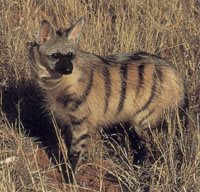Aardwolf

Taxonomy
Kingdom: Animalia
Phylum: Chordata
Class: Mammalia
Order: Carnivora
Superfamily: Feliodea/Aeluroidea
Family: Hyaenidae
Genus: Protelus
Species: Cristatus
Range and Habitat
Aardwolves live in the savannahs of central and southeastern Africa. One distinct population of aardwolves lives in northeastern Sudan through southern Tanzania, while another distinct population lives in southern Angola through Zambia to South Africa.
Appearance
The aardwolf is the fuzziest hyena and also the smallest. They are yellow brown to reddish brown, with a black muzzle and ears, and have black vertical stripes running down their sides. A long mane of hair runs down their back, which they erect when frightened. They have long ears and a pointed nose.
Compared to other hyenas, their hindquarters do not slope as much as the other three species of hyena. They have five toes on their front feet (all other species have four), and they have smaller molars and a weaker jaw tone - unlike the powerful jaws of other hyenas, the aardwolf's jaw is so feeble it cannot chew meat.
Diet
Aardwolves are insectivores. Their primary food source is termites. They will also eat other insects, such as beetle larvae and maggots, which is why aardwolves are found near carrion. Aardwolves do not eat carrion - they eat the insects found with the carrion.
Reproduction
The gestation period is 13-15 weeks, and the female gives birth to 2-4 young at a time, of which 2 generally survive.
Sources conflict on whether or not aardwolves are monogamous or promiscuous, and whether or not the male and female raise the cubs together or whether the females raise the cubs in small groups of females.
Behaviour
Aardwolves are nocturnal. They are shy and elusive. They often steal burrows from aardvarks, probably because of the proximity to a good supply of termites. It is hard to study aardwolves because of their nocturnal and elusive habits.
Threats
The aardwolf is considered at low risk in the wild, however the risk is rising because of pesticide use. The greatest threat to the aardwolf is the use of pesticides to control locusts.